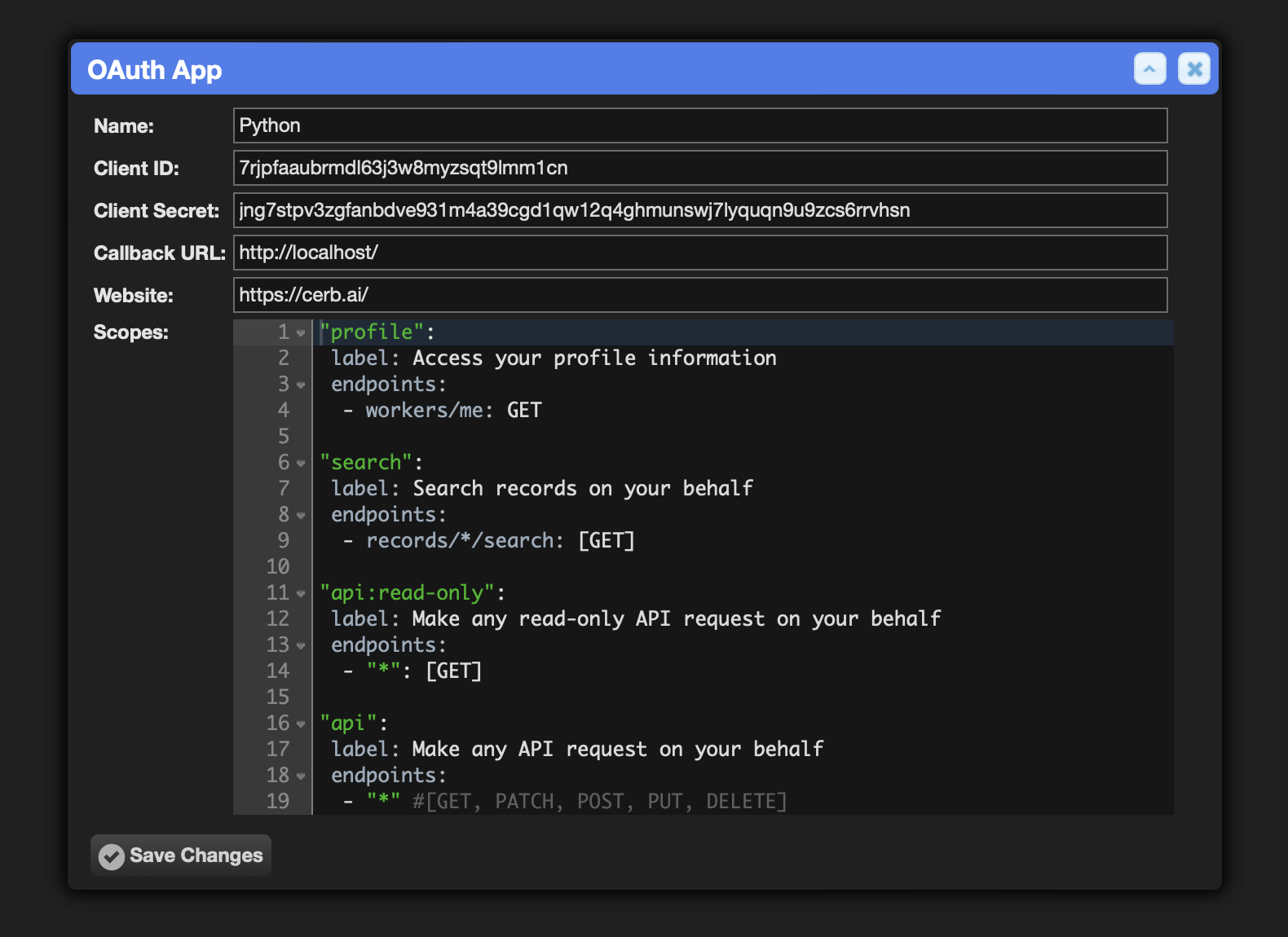Get started with the API using Python
Introduction
This step-by-step guide demonstrates how to use the Cerb API from Python.
We'll be using the requests-oauthlib library to handle OAuth2 authentication.
Create an OAuth app in Cerb
In Cerb, create an OAuth app to generate client credentials.
As an admin you can do this from Search » OAuth Apps » (+).
| Field | Value |
|---|---|
| Name: | (the name of your integration) |
| Client ID: | (auto-generated) |
| Client Secret: | (auto-generated) |
| Callback URL: | (your endpoint for interactive auth, or an arbitrary URL for machine-to-machine auth) |
| Website: | (your website) |
| Scopes: | (customize or use defaults) |

Click the Save Changes button.
Python code
The rest of this guide assumes you have a Python project or Jupyter notebook.
Add the following dependencies using your preferred package manager:
pip install requests requests-oauthlibSet OAuth2 variables
redirect_uri = 'http://localhost/'
request_base_url = 'http://localhost/'
auth_url = request_base_url + 'oauth/authorize'
token_url = request_base_url + 'oauth/access_token'
extra = {
'client_id': '...',
'client_secret': '...',
}| Variable | Description |
|---|---|
redirect_uri |
This must match the Callback URL defined in the OAuth App in Cerb. When using interactive authentication with consent, the user's browser will be redirected here after logging in and approving the link. For local testing this should be your Cerb URL. |
request_base_url |
The base URL of your Cerb install with a trailing slash (/). |
client_id |
The generated Client ID from the OAuth App in Cerb. |
client_secret |
The generated Client Secret from the OAuth App in Cerb. |
Optionally disable SSL
If you're in a test environment (e.g. localhost) you can disable the SSL requirement.
Otherwise, skip this step.
import os
os.environ['OAUTHLIB_INSECURE_TRANSPORT'] = '1'Imports
Import the following:
import json
from requests_oauthlib import OAuth2SessionHandle token persistence
Define a function to persist the generated token. This can store the token object in the filesystem, a database, etc.
def token_saver(token):
# [TODO] Persist the token somewhere
passGenerate a token
There are two options to generate a token. You only need to implement one of them.
Option 1: Provide a pre-generated token
If you generated a token from Setup » Developers » OAuth2 Token Generator you can skip interactive authentication.

Set access_token, refresh_token, and expires_in.
def token_loader():
# [TODO] Load the token from somewhere (inverse of token_saver)
return {
'token_type': 'Bearer',
'expires_in': 300,
'access_token': 'eyJ0...',
'refresh_token': 'def500...',
}
oauth = OAuth2Session(client_id=extra['client_id'], token=token_loader(), auto_refresh_url=token_url, auto_refresh_kwargs=extra, token_updater=token_saver)This code is configured to automatically refresh the access token when it expires (by default hourly).
This example sets the token variable inline, but in production you would load the token previously saved in token_saver().
Option 2: Generate tokens from 3-legged interactive web auth
If you prefer to use 3-legged authentication with user consent, these are the steps.
In this example you manually paste the authorization URL in your browser, then copy the browser URL you are redirected to and paste it into your script for processing.
In production, you'd use an HTTP redirect to the authorization_url and the Callback URL would route back to your app for requesting a token after the worker logs in and consents.
For machine-to-machine scripts, Option 1 above is much simpler.
scopes = ['api']
oauth = OAuth2Session(client_id=extra['client_id'], redirect_uri=redirect_uri, scope=scopes, auto_refresh_url=token_url, auto_refresh_kwargs=extra, token_updater=token_saver)
authorization_url, state = oauth.authorization_url(auth_url, access_type="offline")
print('Visit %s in your browser and authorize access.' % authorization_url)Paste the URL into your browser and log in if required. Click the Accept button.
You'll be redirected back to Cerb. Copy the new URL in the browser location bar and paste it into the next step.
authorization_response = input("Paste the callback URL from your browser location bar:")
token = oauth.fetch_token(
token_url,
authorization_response=authorization_response,
client_secret=extra['client_secret']
)Make a request to the Cerb API
The oauth client object will automatically add the bearer token to the Authorization: HTTP header.
r = oauth.get(request_base_url + 'rest/workers/me.json')Display the response
import json
json.loads(r.content)You should see JSON output like:
{
"__build": 2023091401,
"__status": "success",
"__version": "10.4.4",
"_context": "cerberusweb.contexts.worker",
"_label": "Jeff Standen",
"_type": "worker",
"first_name": "Jeff",
"full_name": "Jeff Standen",
"gender": "M",
"id": 123,
"is_disabled": 0,
"is_superuser": 1,
"language": "en_US",
"last_name": "Standen",
"record_url": "https://cerb.example/profiles/worker/1-Jeff-Standen",
"time_format": "D, d M Y h:i a",
"timeout_idle_secs": 600,
"timezone": "America/Los_Angeles",
"title": "Administrator",
"updated": 1695067418
}Next steps
You can refer to the API documentation for a full list of possible requests.